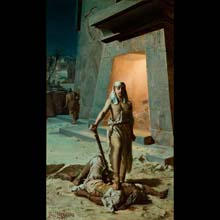
material: oil on canvas
dimensions: 163 × 98 cm
description: During his studies at École des Beaux-Arts in Paris, Paweł Merwart painted one of the most important works in his oeuvre, exhibited at the 1883 Salon in Paris, depicting young Moses over the body of an Egyptian killed by him. The composition illustrates a scene described in the Old Testament, in the Book of Exodus, and expanded in Talmudic legends recalling the events when the Hebrew Nathan said to Moses: “My lord, this Egyptian came to my house in the night, bound me, and dishonoured my wife Salonica in my presence. Having heard this, young Moses killed the Egyptian.” The scene, representing the genre valued most in the academic hierarchy of subjects, was rendered by the artist with historical accuracy and with attention to authentic circumstances in which it could have been set. At the same time, the painter focused on the psychological side of the representation, in particular, of the figure of Moses. He is calm and appears aware of the fact that he has fulfilled God’s order. Moreover, a prophetic voice whispers to him that he will liberate his people from Egyptian bondage, grant them laws and see the countenance of God. Paweł Merwart himself pointed to this in a letter to Seweryn Böhm: “my idea was to express in the figure of young Moses a beautiful revelation of his divine mission – avenging the aggrieved, punishing the oppressor. […] nobody has understood this great biblical figure so clearly before.” Urszula Kozakowska-Zaucha
exposition: The Gallery of 19th Century Polish Art in Sukiennice,
The Cloth Hall, 1, Main Market Square
key: Around the academy >>>
dimensions: 163 × 98 cm
description: During his studies at École des Beaux-Arts in Paris, Paweł Merwart painted one of the most important works in his oeuvre, exhibited at the 1883 Salon in Paris, depicting young Moses over the body of an Egyptian killed by him. The composition illustrates a scene described in the Old Testament, in the Book of Exodus, and expanded in Talmudic legends recalling the events when the Hebrew Nathan said to Moses: “My lord, this Egyptian came to my house in the night, bound me, and dishonoured my wife Salonica in my presence. Having heard this, young Moses killed the Egyptian.” The scene, representing the genre valued most in the academic hierarchy of subjects, was rendered by the artist with historical accuracy and with attention to authentic circumstances in which it could have been set. At the same time, the painter focused on the psychological side of the representation, in particular, of the figure of Moses. He is calm and appears aware of the fact that he has fulfilled God’s order. Moreover, a prophetic voice whispers to him that he will liberate his people from Egyptian bondage, grant them laws and see the countenance of God. Paweł Merwart himself pointed to this in a letter to Seweryn Böhm: “my idea was to express in the figure of young Moses a beautiful revelation of his divine mission – avenging the aggrieved, punishing the oppressor. […] nobody has understood this great biblical figure so clearly before.” Urszula Kozakowska-Zaucha
exposition: The Gallery of 19th Century Polish Art in Sukiennice,
The Cloth Hall, 1, Main Market Square
key: Around the academy >>>












